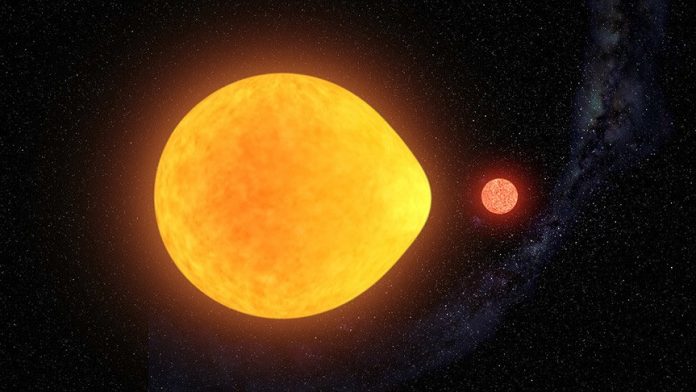A new type of pulsating star — stars whose brightness oscillates periodically — that oscillates largely over only one of its hemispheres has been discovered. The discovery, by an international team of astronomers, including researchers at Penn State, is described in a paper appearing March 9 in the journal Nature Astronomy. The star is located in a binary star system, and its unusual single-sided pulsation is caused by the gravitational pull of its close companion star distorting the oscillations, according to the researchers. The clue that led to the discovery came from citizen scientists.
“Stars that pulsate have been known in astronomy for a long time,” said Zhao Guo, a postdoctoral researcher in astronomy and astrophysics at Penn State and an author of the paper. “The rhythmic pulsations of the stellar surface occur in young and in old stars, can have long or short periods, a wide range of strengths, and different causes. There is however one thing that, until now, all of these stars had in common: The oscillations were always visible on all sides of the star.”
The initial discovery of the unusual behavior of the star was made by citizen scientists who painstakingly inspect the enormous amounts of data that NASA’s Transiting Exoplanet Survey Satellite (TESS) regularly supplies. These amateur astronomy enthusiasts then alert their professional astronomer colleagues when they notice something unusual. The two companion stars in the binary system noticed by the citizen scientists are so close together that they orbit each other every two days. This proximity causes the stars to be distorted into a tear-drop shape by the gravitational pull of their companion.
“The exquisite data from the TESS satellite meant that we could observe variations in brightness due to both the gravitational distortion of the star as well as the pulsations,” said Gerald Handler, professor at the Nicolaus Copernicus Astronomical Center in Poland and lead author of the paper.
After being alerted to the unusual behavior of the pulsating star, the research team observed that the strength of the pulsations depended very strongly on the angle at which the star was observed, and the corresponding orientation of the star within the binary. In addition, the pulsation strength varied with the same periodicity as that of the binary.
“Stars in close binaries can have a teardrop-like shape, so we see different cross-sections of the star at different times,” said Guo. “This is how we could be certain that the pulsations were only found on one side of the star, with the tiny fluctuations in brightness always appearing in our observations when the same hemisphere of the star was pointed towards the telescope.”
The idea that a star’s pulsations could be affected by a close companion was theoretically predicted in the 1940s, and the notion that the axis of that pulsation could be moved by tidal forces — for example, to one of the stars hemispheres — was conjectured over 30 years ago. However, the proof via observational data was missing until now.
“Since the 1980s, we’ve believed that systems like this could exist, but it is only now that we have finally found one,” said Don Kurtz, professor at the University of Central Lancashire in the United Kingdom and a co-author of the study.
While this is the first such star to be found where only one side is pulsating, the research team believes that there must be more such stars.
“Beyond its pulsations, there doesn’t seem to be anything special about this system, so we expect to find many more hidden in the TESS data,” said Saul Rappaport, emeritus professor of physics at the Massachusetts Institute of Technology, co-author of the study, and contact for the citizen scientists.
The research was partially supported by the Penn State Center for Exoplanets and Habitable Worlds, which is funded by the Penn State Eberly College of Science and Department of Astronomy and Astrophysics.













